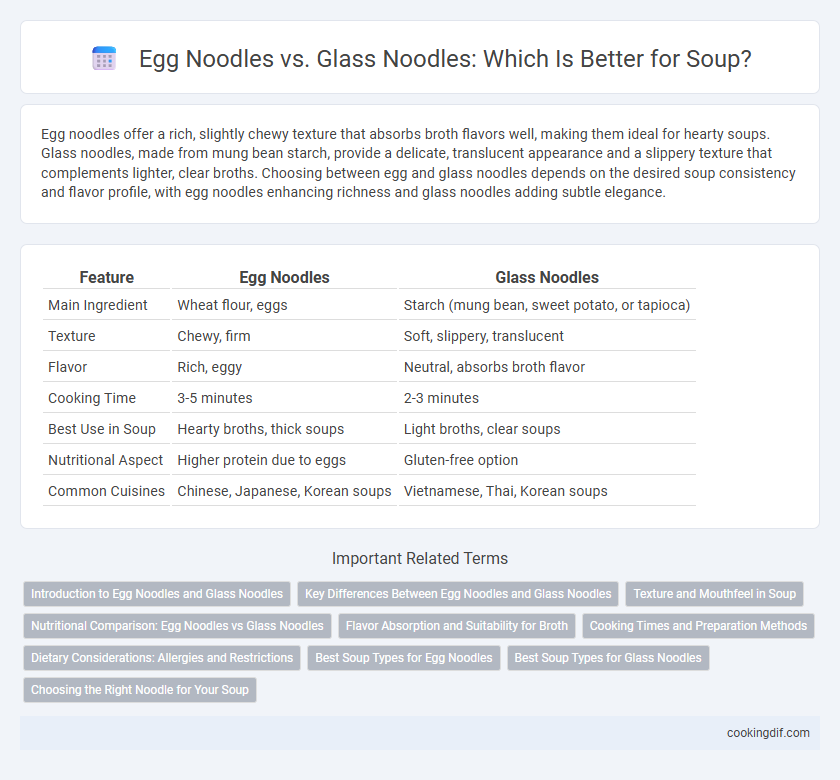Egg noodles offer a rich, slightly chewy texture that absorbs broth flavors well, making them ideal for hearty soups. Glass noodles, made from mung bean starch, provide a delicate, translucent appearance and a slippery texture that complements lighter, clear broths. Choosing between egg and glass noodles depends on the desired soup consistency and flavor profile, with egg noodles enhancing richness and glass noodles adding subtle elegance.
Table of Comparison
| Feature | Egg Noodles | Glass Noodles |
|---|---|---|
| Main Ingredient | Wheat flour, eggs | Starch (mung bean, sweet potato, or tapioca) |
| Texture | Chewy, firm | Soft, slippery, translucent |
| Flavor | Rich, eggy | Neutral, absorbs broth flavor |
| Cooking Time | 3-5 minutes | 2-3 minutes |
| Best Use in Soup | Hearty broths, thick soups | Light broths, clear soups |
| Nutritional Aspect | Higher protein due to eggs | Gluten-free option |
| Common Cuisines | Chinese, Japanese, Korean soups | Vietnamese, Thai, Korean soups |
Introduction to Egg Noodles and Glass Noodles
Egg noodles are made from wheat flour and eggs, giving them a rich flavor and a slightly chewy texture that holds up well in hearty soups. Glass noodles, also known as cellophane noodles, are made from mung bean starch or sweet potato starch, offering a translucent appearance and a slippery, smooth texture that absorbs broth flavors effectively. Both noodles provide unique culinary experiences, with egg noodles adding substance and glass noodles delivering lightness in soups.
Key Differences Between Egg Noodles and Glass Noodles
Egg noodles, made from wheat flour and eggs, have a chewy texture and rich flavor, making them ideal for hearty soups like chicken noodle. Glass noodles, crafted from mung bean or sweet potato starch, become translucent and slippery when cooked, offering a lighter, more delicate bite perfect for clear broths or Asian-inspired soups. The main differences lie in their base ingredients, texture, and how they absorb flavors, influencing the soup's overall mouthfeel and taste profile.
Texture and Mouthfeel in Soup
Egg noodles offer a firm and chewy texture that holds its shape well in soup, providing a satisfying bite. Glass noodles deliver a slippery, smooth mouthfeel that easily absorbs the broth's flavors, creating a delicate eating experience. The contrasting textures impact the overall soup enjoyment, with egg noodles adding heartiness and glass noodles enhancing lightness.
Nutritional Comparison: Egg Noodles vs Glass Noodles
Egg noodles contain higher protein and fat content due to their wheat flour and egg composition, providing more energy and essential amino acids. Glass noodles, made from mung bean starch or sweet potato starch, are lower in calories, fat, and protein but offer a gluten-free option ideal for sensitive diets. Both noodles supply carbohydrates for energy, but egg noodles deliver more vitamins like B12 and minerals such as iron, enhancing nutritional value in soups.
Flavor Absorption and Suitability for Broth
Egg noodles, with their dense texture and slightly chewy consistency, excel at absorbing rich, savory broths, enhancing the soup's overall flavor profile. Glass noodles, made from mung bean starch, offer a translucent, slippery texture that soaks up lighter, clear broths subtly while maintaining their springy bite. Egg noodles are ideal for hearty, robust soups, whereas glass noodles suit delicate, aromatic broths where gentle flavor infusion is desired.
Cooking Times and Preparation Methods
Egg noodles typically cook in 4 to 6 minutes, requiring boiling water and minimal soaking, while glass noodles need a longer soaking time of about 10 to 15 minutes in hot water before briefly boiling or stir-frying. Egg noodles have a chewy texture and maintain firmness when cooked quickly, whereas glass noodles become slippery and translucent, absorbing broth flavors effectively. Preparation of egg noodles involves straightforward boiling, while glass noodles demand careful soaking to avoid overcooking and becoming mushy in soup.
Dietary Considerations: Allergies and Restrictions
Egg noodles contain wheat and eggs, making them unsuitable for individuals with gluten intolerance or egg allergies, while glass noodles are typically made from mung bean starch or sweet potato starch, making them gluten-free and hypoallergenic. People with celiac disease or egg sensitivity often prefer glass noodles as a safer alternative in soups. It is important to check ingredient labels, as some glass noodles may contain additives or cross-contaminants affecting dietary restrictions.
Best Soup Types for Egg Noodles
Egg noodles, with their chewy texture and ability to absorb rich broths, are ideal for hearty soups such as chicken noodle, beef stroganoff, and creamy mushroom soups. Their wheat-based composition makes them perfect for soups requiring robust, thick noodles that maintain structure without becoming mushy. Glass noodles, made from mung bean starch, suit lighter, clear soups like Vietnamese pho or hot and sour soup, offering a slippery texture rather than the dense bite of egg noodles.
Best Soup Types for Glass Noodles
Glass noodles, made from mung bean starch, excel in clear and light soups like Korean japchae or Vietnamese pho due to their translucent texture and ability to absorb broth flavors. Their delicate chewiness pairs well with broths infused with herbs, seafood, or soy-based seasoning, enhancing dishes such as hot pot or miso soup. Unlike egg noodles, glass noodles remain softer and more flexible, making them ideal for soups that require extended simmering without becoming overly dense.
Choosing the Right Noodle for Your Soup
Egg noodles offer a rich, chewy texture and absorb flavors well, making them ideal for hearty soups like chicken noodle or beef stew. Glass noodles, made from mung bean starch, provide a delicate, translucent appearance and a slightly slippery texture that complements light, clear broths such as Asian-inspired soups. Selecting the right noodle depends on the soup's flavor profile and desired texture, with egg noodles enhancing robustness and glass noodles adding subtle elegance.
Egg noodles vs glass noodles for soup Infographic

 cookingdif.com
cookingdif.com